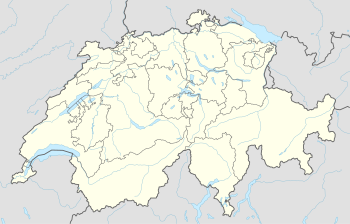Lucens reactor
| Lucens reactor | |
|---|---|
 Control room of the Lucens reactor in April 1968 | |
 | |
| Official name | Versuchsatomkraftwerk Lucens |
| Country | Switzerland |
| Location | Lucens, Vaud |
| Coordinates | 46°41′34.16″N 6°49′36.81″E / 46.6928222°N 6.8268917°E |
| Status | Decommissioned |
| Construction began | 1 April 1962 |
| Commission date | 10 May 1968 |
| Decommission date | 3 March 1969 |
| Owner | Nationale Gesellschaft zur Förderung der industriellen Atomtechnik |
| Operator | Energie Ouest Suisse |
| Nuclear power station | |
| Reactor type | HWGCR |
| Reactor supplier | Thermatom |
| Cooling source | Carbon dioxide |
| Power generation | |
| Units decommissioned | 1 x 6 MW[1] |
| Nameplate capacity | 6 MW |
| External links | |
| Website | www |
| Commons | Related media on Commons |
Suffered a nuclear accident on 21 January 1969, leading to a partial core meltdown and massive radioactive contamination | |
The Lucens reactor was a 6 MW experimental nuclear power reactor built next to Lucens, Vaud, Switzerland. After its connection to the electrical grid on 29 January 1968, the reactor only operated for a year before it suffered an accident on 21 January 1969. The cause was a corrosion-induced loss of heat dispersal leading to the destruction of a pressure tube which caused an adjacent pressure tube to fail, and partial meltdown of the core, resulting in radioactive contamination of the cavern.[1][2][3][4]
Description
In 1962 the construction of a Swiss-designed pilot nuclear power plant began.[1][5][6][7] The heavy-water moderated, carbon dioxide gas-cooled reactor was built in a cavern.[8] It produced 28 MW of heat, which was used to generate 6 MW of electricity, and it became critical 29 December 1966.[1] It was fueled by 0.96% enriched uranium alloyed with chromium cased in magnesium alloy (magnesium with 0.6% zirconium) inserted into a graphite matrix. Carbon dioxide gas was pumped into the top of the channels at 6.28 MPa and 223 °C and exited the channels at a pressure of 5.79 MPa and at a temperature of 378 °C.[9]
Nuclear accident
It was intended to operate until the end of 1969, but during a startup on 21 January 1969, it suffered a loss-of-coolant accident, leading to a partial core meltdown and the radioactive contamination of the cavern, which was then sealed.[10] Using the criteria of the International Nuclear Event Scale, introduced in 1990 by the International Atomic Energy Agency, the event has been assessed as a Level 4 "Accident with local consequences".[11]
The accident was caused by water condensation forming on some magnesium alloy fuel element components during shutdown and corroding them. These corrosion products accumulated in some fuel channels. One of the vertical fuel channels was sufficiently blocked by it to impede the flow of carbon dioxide coolant, causing the magnesium alloy cladding to melt and further block the channel. The increase in temperature and exposure of the uranium metal fuel to the coolant eventually caused the fuel to catch fire in the carbon dioxide coolant atmosphere. The pressure tube surrounding the fuel channel split because of overheating and bowing of the burning fuel assembly, and the carbon dioxide coolant leaked out of the reactor.[12][13]
No irradiation of workers or the population occurred, though the reactor's cavern was seriously contaminated. The cavern was decontaminated, and the reactor was dismantled over the next few years. The plant was decommissioned in 1988, and the last radioactive waste was removed in 2003.[14][15]
See also
References
- ^ a b c d "LUCENS – Reactor Details". IAEA Power Reactor Information System. International Atomic Energy Agency. Retrieved 8 October 2016.
- ^ Geoffrey F. Hewitt; John G. Collier (8 October 2018). Introduction to Nuclear Power. Taylor & Francis. p. 186. ISBN 978-1-4822-2132-9.
- ^ Catherine Mei Ling Wong (9 December 2017). Energy, Risk and Governance: The Case of Nuclear Energy in India. Springer. p. 262. ISBN 978-3-319-63363-3.
- ^ J. Wolters: Aufgetretene Unfälle mit Kernschäden; in Atomwirtschaft, Juni 1987
- ^ Anthony, L. J. (1966). Sources of Information on Atomic Energy – International Series of Monographs in Library and Information Science. Vol. 2. Elsevier. p. 85. ISBN 978-1-4831-5600-2.
- ^ Wildi, Tobias (2003). Der Traum vom eigenen Reaktor – die schweizerische Atomtechnologieentwicklung 1945–1969 (PDF) (in German). Chronos. doi:10.3929/ethz-a-004459704. hdl:20.500.11850/88080. ISBN 978-3-0340-0594-4.
{{cite book}}:|journal=ignored (help) - ^ Hug, Peter (2009). "Energie nucléaire". Dictionnaire historique de la Suisse (in French). Hauterive: Gilles Attinger. Retrieved 9 October 2016.
- ^ Summary of Swiss nuclear reactors, SAPIERR Support Action: Pilot Initiative for European Regional Repositories Archived 19 July 2011 at the Wayback Machine
- ^ Heavy water reactors : status and projected development (PDF). Vienna: International Atomic Energy Agency. 2002. ISBN 978-9201115027.
- ^ J. Wolters: Aufgetretene Unfälle mit Kernschäden; in Atomwirtschaft, Juni 1987
- ^ Ha-Duong, Minh; Journé, Venance (14 May 2014). "Calculating nuclear accident probabilities from empirical frequencies". Environment Systems and Decisions. 34 (2): 249–258. Bibcode:2014EnvSD..34..249H. doi:10.1007/s10669-014-9499-0. ISSN 2194-5403. S2CID 8507107.
- ^ Description of events, Nuclear tourist
- ^ Heavy water reactors: Status and projected development Archived 13 April 2007 at the Wayback Machine, IAEA, 2002
- ^ "On-site disposal as a decommissioning strategy" (PDF). International Atomic Energy Agency. November 1999. p. 67. Retrieved 6 January 2013.
- ^ "Switzerland's first nuclear plant decommissioned". SWI swissinfo.ch. Retrieved 11 October 2016.

